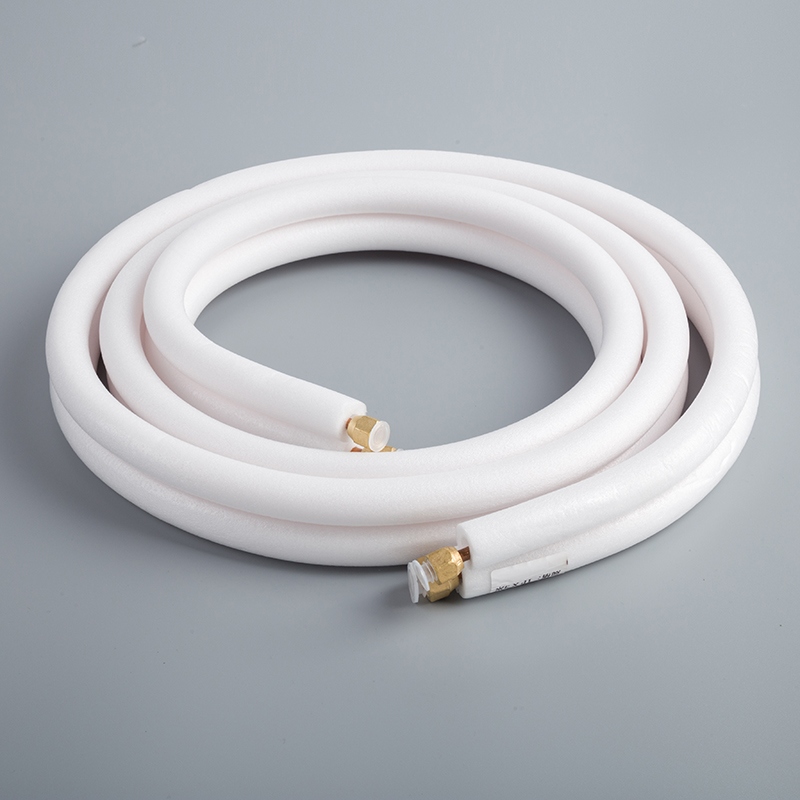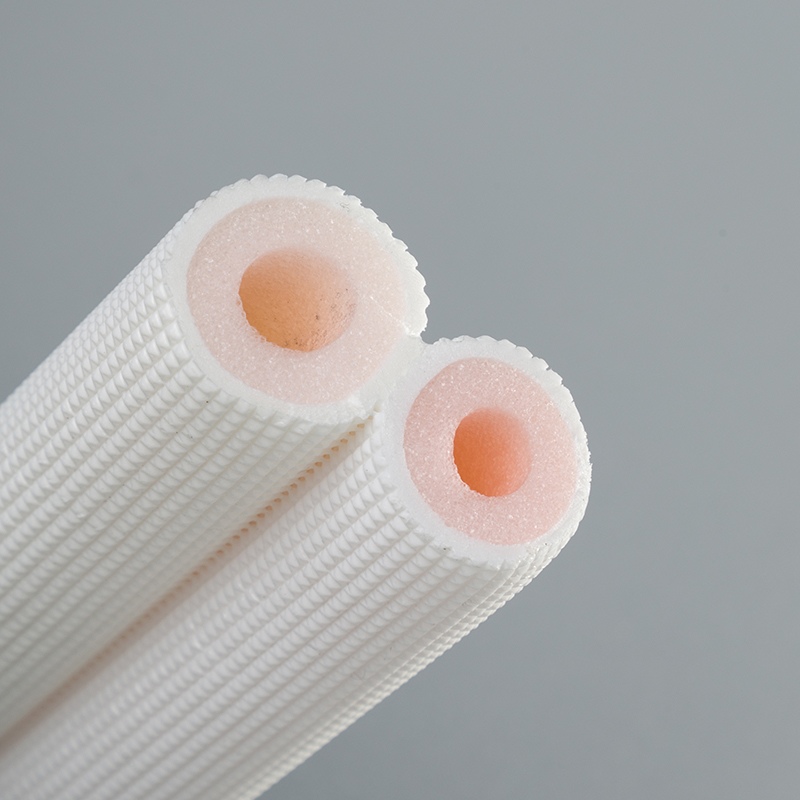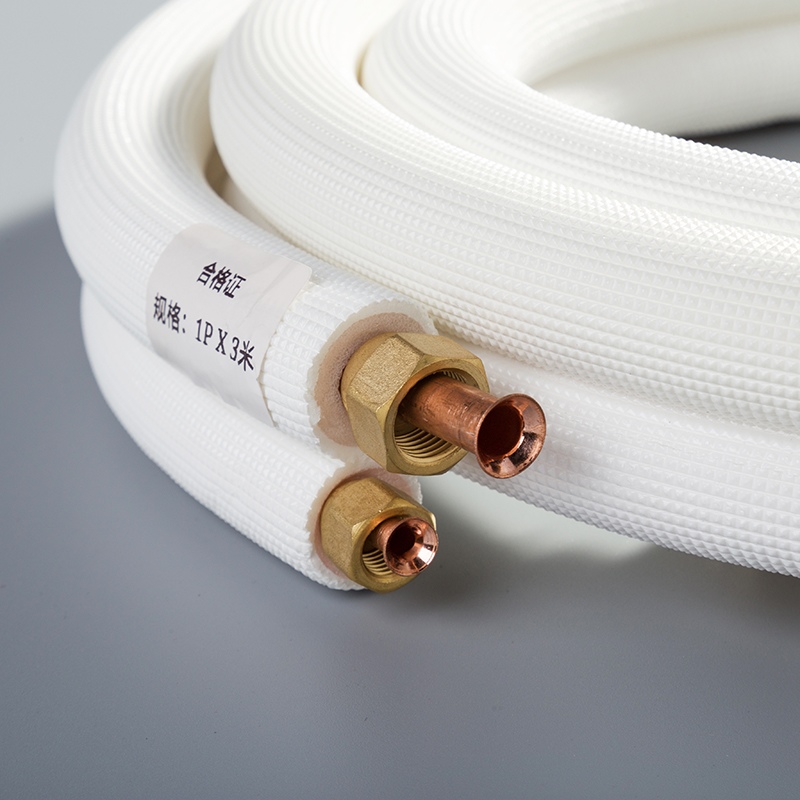How to Install Thermal Insulation on Copper Pipes for Home Air Conditioning

Thermal insulation is essential for maintaining the efficiency of your home air conditioning system. By using wholesale thermal insulation copper control pipe for home air conditioning gas powered rubber materi, you can effectively prevent heat exchange between the refrigerant and the environment, thereby enhancing energy efficiency. Proper insulation of air conditioner copper pipes can lead to significant savings on energy bills, with the EPA estimating up to 15% savings on heating and cooling costs. Insulating these lines also reduces wear and tear on your HVAC system, extending its lifespan. Whether you're dealing with the suction line or the liquid line, ensuring proper insulation with these materials is key to achieving optimal performance.
Key Takeaways
Proper insulation of copper pipes can lead to up to 15% savings on energy bills by enhancing the efficiency of your air conditioning system.
Choose the right insulation material—options like foam, rubber, and fiberglass each offer unique benefits for different applications.
Before installation, ensure pipes are clean and free from old insulation to maximize the effectiveness of the new insulation.
Accurate measurement and precise cutting of insulation are crucial for a snug fit, preventing gaps that could lead to energy loss.
Regularly inspect your insulation for signs of wear, such as discoloration or cracks, to maintain optimal performance and prevent costly repairs.
Seal all joints and seams with appropriate adhesive or tape to prevent air and moisture infiltration, ensuring the longevity of your insulation.
Follow safety precautions during installation, including wearing protective gear and ensuring proper ventilation to create a safe working environment.
Types of Insulation Materials

When it comes to air conditioner copper pipe insulation, selecting the right material is crucial for maintaining system efficiency and longevity. Different insulation materials offer unique benefits, making them suitable for various applications. Here, we explore some popular options:
Foam Insulation
Foam insulation is a versatile choice for insulating copper pipes. Polyethylene foam insulation stands out due to its lightweight nature and cost-effectiveness. You will find it easy to handle and install, making it a reliable option for air conditioner copper pipe insulation. This material provides excellent thermal resistance and is resistant to chemicals and moisture, ensuring long-lasting performance.
Rubber Insulation
Rubber insulation, often referred to as foam rubber insulation, is another excellent option. Aflex-Eco Nitrile Insulation Foam is a notable product in this category. It is made from synthetic rubber-like elastomeric foam, which offers flexibility and durability. This type of insulation is suitable for both indoor and outdoor applications, providing robust protection against moisture. Its adaptability to different pipe diameters makes it a preferred choice for many homeowners.
Fiberglass Insulation
Fiberglass insulation is commonly used in HVAC systems for its superior thermal insulating properties. Composed of tiny glass fibers, it effectively reduces heat transfer along refrigerant lines. However, you must ensure proper sealing to prevent moisture infiltration, which can compromise its effectiveness. This insulation type is particularly beneficial for maintaining energy efficiency in your air conditioning system.
Choosing the right insulation material for your copper pipes can significantly impact the performance and efficiency of your air conditioning system. By understanding the characteristics of each type, you can make an informed decision that best suits your needs.
Closed-cell Elastomeric Insulation
Closed-cell elastomeric insulation stands out as a top choice for copper pipe insulation in air conditioning systems. This type of insulation material offers several advantages that make it highly effective for maintaining the efficiency of your HVAC system.
Key Features of Closed-cell Elastomeric Insulation:
Low Thermal Conductivity: This insulation material minimizes heat transfer, ensuring that your air conditioning system operates efficiently. By reducing energy loss, it helps maintain the desired temperature within your home.
Vapor Retardant: Closed-cell elastomeric insulation effectively prevents moisture infiltration. This feature is crucial because moisture can lead to condensation, which may cause damage to the pipes and reduce the insulation's effectiveness.
Flexibility and Durability: The material's flexibility allows it to accommodate the expansion and contraction of copper pipes during system operation. Its durability ensures long-lasting performance, even in varying environmental conditions.
When you choose closed-cell elastomeric insulation, you benefit from its ability to provide robust protection against both thermal and moisture-related issues. This makes it an excellent option for both residential and commercial applications.
Installation Tips:
Measure Accurately: Before installation, measure the length and diameter of the copper pipes to ensure you have the correct size of insulation.
Cut Precisely: Use a sharp utility knife to cut the insulation to the required length. Ensure clean cuts to avoid gaps that could compromise the insulation's effectiveness.
Seal Joints and Seams: After wrapping the insulation around the pipes, use adhesive or tape specifically designed for elastomeric materials to seal any joints or seams. This step is vital to prevent air and moisture infiltration.
By following these steps, you can maximize the benefits of closed-cell elastomeric insulation, ensuring your air conditioning system remains efficient and reliable.
Preparation Steps
Before you begin the process of insulating ac lines, it's crucial to prepare adequately. Proper preparation ensures a smooth and efficient installation, enhancing the overall energy efficiency of your air conditioning system.
Necessary Tools
To successfully install air conditioner copper pipe insulation, gather the following tools:
Measuring Tape: Essential for accurately measuring the length and diameter of the copper pipes.
Utility Knife: Use this for cutting the insulation material to the required size.
Adhesive or Insulation Tape: Necessary for sealing joints and seams to prevent air and moisture infiltration.
Gloves: Protect your hands while handling insulation materials.
Safety Goggles: Shield your eyes from any debris during the installation process.
Having these tools on hand will make the copper pipe installation process more efficient and less prone to errors.
Safety Precautions
Safety should always be a priority when working with insulation materials. Follow these precautions to ensure a safe installation:
Wear Protective Gear: Always wear gloves and safety goggles to protect yourself from potential irritants in the insulation materials.
Ensure Proper Ventilation: Work in a well-ventilated area to avoid inhaling any dust or particles from the insulation.
Handle Tools Carefully: Use the utility knife with caution to avoid accidental cuts or injuries.
Check for Hazards: Before starting, inspect the work area for any potential hazards, such as exposed electrical wires or sharp objects.
By adhering to these safety measures, you can confidently proceed with insulating ac lines, ensuring both your safety and the effectiveness of the insulation.
Removing Old Insulation
Before you can install new air conditioner copper pipe insulation, you must first remove any old or damaged insulation. This step is crucial to ensure that the new insulation adheres properly and performs effectively.
Identifying Worn or Damaged Insulation
To begin, you need to identify areas where the insulation is worn or damaged. Look for signs such as:
Discoloration: Faded or discolored insulation often indicates exposure to moisture or heat.
Cracks or Tears: Physical damage like cracks or tears can compromise the insulation's effectiveness.
Loose or Sagging Sections: Insulation that has become loose or saggy may not provide adequate coverage.
By carefully inspecting the copper pipes, you can pinpoint sections that require attention. This step ensures that you only remove insulation that truly needs replacement, saving time and resources.
Safe Removal Techniques
Once you've identified the damaged areas, proceed with caution to remove the old insulation. Follow these steps to ensure a safe and efficient removal process:
Wear Protective Gear: Equip yourself with gloves, safety goggles, and a mask. These items protect you from potential irritants and debris during the removal process. A long-sleeved shirt and long pants can also help minimize skin contact with insulation fibers.
Use the Right Tools: A utility knife is essential for cutting through the insulation. Ensure the blade is sharp to make clean cuts. A vacuum designed for insulation can help manage dust and debris, keeping your workspace clean.
Cut and Remove: Carefully cut along the length of the damaged insulation using the utility knife. Gently peel away the insulation, taking care not to damage the copper pipes underneath.
Dispose Properly: Place the removed insulation in a sealed bag to prevent fibers from spreading. Dispose of it according to local regulations, ensuring environmental safety.
By following these techniques, you can safely remove old insulation, preparing the copper pipes for new air conditioner copper pipe insulation. This preparation step is vital for achieving optimal performance and energy efficiency in your HVAC system.
Cleaning the Copper Pipes
Before installing new air conditioner copper pipe insulation, you must ensure the pipes are clean. A clean surface allows the insulation to adhere properly, maximizing its effectiveness and longevity.
Tools for Cleaning
To clean copper pipes effectively, gather the following tools:
Soft Cloth or Sponge: Use these to wipe down the pipes gently, removing any loose dirt or debris.
Mild Detergent or Vinegar Solution: Mix a small amount of detergent or vinegar with water to create a cleaning solution. This helps in breaking down grime without damaging the copper.
Brush with Soft Bristles: A soft-bristled brush can help scrub away stubborn dirt or residue without scratching the pipe surface.
Bucket of Warm Water: Rinse the pipes thoroughly with warm water after cleaning to remove any remaining detergent or vinegar solution.
These tools will help you achieve a clean and smooth surface, essential for the proper application of insulation.
Ensuring a Clean Surface for New Insulation
Once you have your tools ready, follow these steps to ensure the copper pipes are clean and ready for insulation:
Inspect the Pipes: Begin by visually inspecting the copper pipes for any visible dirt, grime, or residue. Identifying these areas will help you focus your cleaning efforts where they are most needed.
Apply Cleaning Solution: Dip the soft cloth or sponge into the mild detergent or vinegar solution. Gently wipe down the pipes, ensuring you cover all areas. The solution will help dissolve any grease or grime.
Scrub Stubborn Areas: Use the soft-bristled brush to scrub any areas with stubborn dirt. Be gentle to avoid scratching the copper surface.
Rinse Thoroughly: After cleaning, rinse the pipes with warm water. This step is crucial to remove any cleaning solution residue that could interfere with the insulation's adhesion.
Dry Completely: Use a dry cloth to wipe the pipes, ensuring they are completely dry before applying new insulation. Moisture can hinder the insulation process and lead to issues like mold growth.
By following these steps, you prepare the copper pipes for effective air conditioner copper pipe insulation. A clean surface ensures the insulation adheres well, providing optimal thermal resistance and energy efficiency.
Installing New Insulation

Proper installation of new insulation on your copper pipes is crucial for maintaining the efficiency and longevity of your air conditioning system. Follow these steps to ensure a successful installation.
Measuring and Cutting Insulation
Accurate measurement and cutting of insulation are essential for a snug fit around your copper pipes. Begin by measuring the length and diameter of the pipes using a measuring tape. This ensures you have the correct size of insulation material, whether it's foam rubber insulation or polyethylene foam insulation.
Measure the Pipes: Use a measuring tape to determine the length and diameter of both the suction line and liquid line. This step is vital for selecting the right size of insulation.
Cut the Insulation: With a utility knife, cut the insulation to the required length. Ensure clean cuts to avoid gaps that could compromise the insulation's effectiveness. A precise fit enhances energy efficiency by minimizing heat transfer.
Securing Insulation to Pipes
Once you've cut the insulation to size, it's time to secure it to the copper pipes. This step involves wrapping the insulation around the pipes and ensuring it stays in place.
Wrap the Insulation: Carefully wrap the insulation around the copper pipes. Make sure it covers the entire length of the refrigerant line insulation, including both the suction line and liquid line. This coverage prevents condensation and energy loss.
Secure with Adhesive or Tape: Use adhesive or insulation tape to secure the insulation in place. This step is crucial for preventing the insulation from slipping or becoming loose over time.
Sealing Joints and Seams
Sealing the joints and seams of the insulation is the final step in the installation process. Proper sealing ensures that no air or moisture can penetrate the insulation, which could reduce its effectiveness.
Seal the Joints: After wrapping the insulation, use adhesive or tape specifically designed for insulation materials to seal any joints. This prevents air infiltration and maintains the insulation's integrity.
Check for Gaps: Inspect the insulation for any gaps or exposed areas. Ensure that all seams are tightly sealed to maximize the insulation's thermal resistance.
By following these steps, you can effectively insulate ac lines, enhancing the performance of your air conditioning system. Proper insulation not only improves energy efficiency but also extends the lifespan of your HVAC system by reducing wear and tear.
Maintenance Tips
Regular maintenance of your air conditioner copper pipe insulation ensures optimal performance and extends the life of your HVAC system. By following these tips, you can keep your insulation in top condition.
Regular Inspection for Wear
You should inspect your insulation regularly to catch any signs of wear early. Look for cracks, tears, or any areas where the insulation appears loose. These issues can lead to energy loss and reduced efficiency. A tight seal is crucial for preventing energy loss and ensuring the longevity of your insulation. Make it a habit to check your insulation at least twice a year, ideally before the cooling and heating seasons begin.
Signs of Insulation Deterioration
Recognizing the signs of insulation deterioration helps you address problems before they escalate. Here are some indicators to watch for:
Discoloration: This often suggests exposure to moisture or heat, which can compromise the insulation's effectiveness.
Physical Damage: Cracks or tears in the insulation material can lead to energy inefficiency.
Condensation: If you notice moisture on the surface of the insulation, it might indicate a breach in the vapor barrier.
Addressing these signs promptly can prevent further damage and maintain the efficiency of your air conditioning system.
Tips for Extending Insulation Life
To extend the life of your air conditioner copper pipe insulation, consider these practical tips:
Ensure Proper Installation: During copper pipe installation, make sure the insulation fits snugly around the pipes. This prevents gaps that could lead to energy loss.
Seal Joints and Seams: Use adhesive or tape to seal all joints and seams. This step is vital for keeping air and moisture out, which can degrade the insulation over time.
Protect from Physical Damage: Avoid placing heavy objects on the insulation or exposing it to sharp tools. Physical damage can compromise its integrity.
Regular Cleaning: Keep the insulation clean by wiping it down with a soft cloth. This prevents dirt and debris from accumulating, which can affect its performance.
By following these maintenance tips, you can effectively insulate ac lines and ensure your air conditioning system operates efficiently for years to come.
Proper insulation of your air conditioning system is crucial for maintaining energy efficiency and reducing costs. By using wholesale thermal insulation copper control pipe for home air conditioning gas powered rubber materi, you enhance the performance and longevity of your system. Regularly inspect and maintain your air conditioner copper pipe insulation to prevent issues like condensation and energy loss. As experts suggest, consistent inspections help you catch problems early, ensuring a comfortable home environment. Embrace these practices to insulate ac lines effectively, achieving a sustainable and efficient living space.
FAQ
What is the primary benefit of insulating copper pipes in an air conditioning system?
Insulating copper pipes in your air conditioning system primarily enhances energy efficiency. By reducing heat exchange between the refrigerant and the environment, insulation helps maintain a stable indoor temperature. This not only optimizes the system's performance but also leads to significant cost savings on energy bills.
How often should I inspect the insulation on my copper pipes?
You should inspect the insulation on your copper pipes at least twice a year. Regular inspections help you identify any signs of wear or damage early. This proactive approach ensures that your HVAC system remains efficient and prevents potential issues from escalating.
Can I install insulation on copper pipes myself, or should I hire a professional?
You can install insulation on copper pipes yourself if you have the necessary tools and follow safety precautions. However, if you're unsure or uncomfortable with the process, hiring a professional ensures proper installation. This guarantees optimal performance and longevity of your air conditioning system.
What are the signs that my pipe insulation needs replacement?
Look for discoloration, cracks, tears, or loose sections in your pipe insulation. These signs indicate that the insulation may no longer be effective. Prompt replacement prevents energy loss and maintains the efficiency of your HVAC system.
Why is closed-cell elastomeric insulation recommended for air conditioning systems?
Closed-cell elastomeric insulation is recommended because it offers low thermal conductivity and vapor retardant properties. This type of insulation minimizes heat transfer and prevents moisture infiltration, making it ideal for maintaining the efficiency of your air conditioning system.
How does proper insulation contribute to environmental benefits?
Proper insulation reduces energy consumption, which in turn lowers your carbon footprint. By maintaining consistent temperatures and reducing the need for excessive heating or cooling, insulation contributes to energy conservation and environmental sustainability.
What tools do I need for installing insulation on copper pipes?
You will need a measuring tape, utility knife, adhesive or insulation tape, gloves, and safety goggles. These tools help you measure, cut, and secure the insulation effectively, ensuring a snug fit around the pipes.
How does insulation protect copper pipes from damage?
Insulation protects copper pipes by reducing moisture build-up and maintaining consistent temperatures. This protection minimizes the risk of corrosion and physical damage, thereby prolonging the lifespan of your HVAC system.
Is there a specific type of insulation that works best for outdoor copper pipes?
Rubber insulation, particularly foam rubber insulation, is suitable for outdoor copper pipes. It offers flexibility and durability, providing robust protection against moisture and varying environmental conditions.
How does proper insulation affect indoor comfort?
Proper insulation maintains a stable indoor temperature, enhancing comfort regardless of external weather conditions. By preventing heat loss or gain, insulation ensures a comfortable living environment while reducing energy costs.
See Also
Enhance Your AC Performance Using Copper Pipe Insulation
Find the Perfect Insulation Solution for Copper Tubing
Reasons to Opt for Copper Pipes in AC Systems


